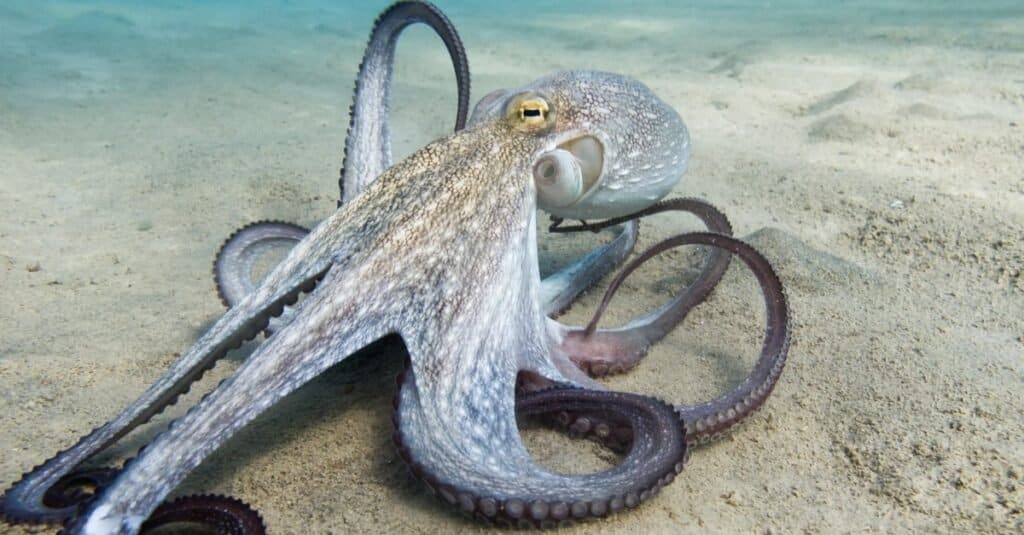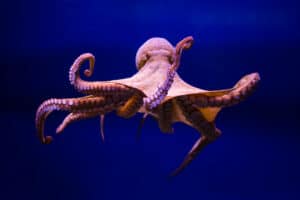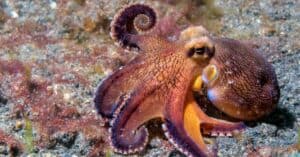The octopus is one of the world’s most alien creatures, but nothing puts that into perspective more than the physiological differences between them and the creatures we’re most familiar with. Like cockroaches and squid, the octopus’ neurology is controlled by multiple separate brains — nine in the case of this strange octopod. And plenty of their skills of manipulation come down to the fact that they can use those brains to control eight distinct tentacles. But their circulatory system is just as unusual. The octopus has multiple hearts, and that fact can reveal secrets about its evolutionary history while also informing our understanding of how they manipulate their environments. Here are all the facts you need to know about octopus hearts.
How the Heart Works
Not every animal has a heart. Sea anemones and starfish both get by without a dedicated organ for pumping blood — but the fact that the jellyfish is the largest animal without a heart is an indication of the necessity of a heart for animals that are physiologically sophisticated beyond a certain level. The notion of a circulatory system driven by a centralized pump that can deliver blood throughout the body first evolved approximately 600 million years ago, and it’s since been a staple of almost all animal life. Regardless of whether you’re discussing a bald eagle, a tree frog, or a bumblebee, the function is the same — delivering nutrients and oxygen to nourish the body’s tissues and disposing of any waste in circulation.
Most animals have a single heart, but even those can vary significantly in terms of design and functionality. The aforementioned bumblebee has an open circulatory system with a heart that runs the length of the body and simply spills blood over the organs. The exceedingly long neck of Africa’s giraffe requires these equines to possess incredibly powerful hearts with thick cardiac walls that are capable of pumping blood efficiently all the way to their brains. The world’s fastest land mammal — the cheetah — also has an incredibly fast heart, and one capable of exceptional acceleration. Scientific facts indicate it can double its resting heart rate of around 120 BPM over the course of a few seconds.

©Andrea Izzotti/Shutterstock.com
Why Some Animals Have Multiple Hearts
Tracing an evolutionary tree backward can be difficult. Animals in a family tree will sometimes lose traits that are generally defining features for their group — as is the case with dolphins losing their legs and retreating to live as aquatic mammals. But the facts of the matter are that there are no known mammals, reptiles, amphibians, or birds with multiple hearts. That suggests that the development of more than one heart pump happened far back up the evolutionary tree. It also suggests that these additional hearts developed out of a need to survive in extreme or alien environments, or else they would be likely to recur in more places. Understandably, most animals with multiple hearts appear rather alien to humans.
One of the most primitive and ubiquitous creatures with multiple hearts is the earthworm. The five hearts of this worm are more prototypes of a heart than the real thing, as they’re essentially just specialized blood vessels. Based on the known facts, there’s an argument to be made that cockroaches have 13 hearts — although some scientists argue that it instead possesses a single heart with 13 chambers. For hagfish, the poor quality of the water they live in necessitates a circulatory system that’s capable of filtration, and the result is a series of four hearts that can continue to operate for a full day and a half without oxygen. Both cuttlefish and squid possess three hearts, an evolution they also adapted to remediate the unique difficulties of the aquatic ecosystems they inhabit.
How Many Hearts Does an Octopus Have?
In fact, the circulatory systems of the squid and cuttlefish are functionally the same as the octopus — a revelation that comes down to the fact that they’re all related under the class Cephalopoda. Functionally, cephalopods share similar anatomy to survive in similar environments to each another. Cephalopoda actually translates to “head foot”, and they’re all composed of a head that serves as the anchor point for eight or more arms and a foot that helps them navigate in the water. The number and nature of these arms can vary depending on the animal, but octopus species are particularly well developed. Their eight tentacles are highly sensitive and capable of incredibly fine motor skills, and octopi have already developed nine brains. One central brain serves as central routing for eight separate brains that are each in charge of a different tentacle.
Similarly, octopi and other cephalopods have developed three hearts. All three of these hearts are located within the animal’s head, with the systematic heart serving as the primary circulatory pump and two branchial hearts assisting. This isn’t functionally that different from how the heart works in other creatures, although it does split up the duties. The two branchial hearts take pure blood rich in oxygen and pump it through the octopus’ gills so oxygen and nutrients can be distributed throughout the remote tissues in the body. Once this blood finishes its cycle, it will return to the systematic heart where it will be pressurized and sent back through the cycle.
The size and volume of an octopus’ extremities help partially explain why these cephalopods might need such a specialized circulatory system, but the high amounts of energy required to keep nine separate brains oxygenated could be a serious contributing factor as well. The nautilus is the only cephalopod to not have three hearts, and it’s both physiologically less complex and significantly more sedentary than both the squid and the octopus. But just because this unique three-pump design developed out of evolutionary necessity doesn’t mean that it’s perfectly efficient. Octopi have two primary modes of navigation — crawling along the surface of the sea bed and using their tentacles and current to propel themselves forward. Octopi rely primarily on the former mode of navigation because their systematic heart actually stops working in the process. This inability to exert themselves for extended periods of time could have contributed to octopi developing ambush hunting methods and environmental camouflage as a primary defense mechanism.

©ennar0/Shutterstock.com
Why Do Octopuses Have Blue Blood?
The mystery behind an octopus’ blue blood is actually critical to understanding its need for three hearts. Human blood appears red when it leaves the body because of the presence of an iron-based protein called hemoglobin. Octopi instead use a protein derived from copper known as hemocyanin. Hemocyanin is the heavier of the two, and its unique chemical structure ensures that its blood appears blue when spilled. Octopi have proven very efficient at using all of the oxygen their hearts pump through their body, but that may be less a sign that they have efficient circulatory systems and more a result of necessity. Hemocyanin is only about a quarter as effective as hemoglobin at transporting oxygen, thus necessitating three separate hearts with two specialized for circulation and one for processing.
Studies into a species of octopus that appears in the frigid Antarctic could shed some light on why these animals developed such a seemingly inefficient protein in their blood composition. This species — the Pareledone charcoti — displays considerably higher concentrations of hemocyanin in its blood: roughly 40% more than any other observed octopus species. This doesn’t appear to be coincidental. Researchers believe that this physiological change is meant to help these octopi adapt to colder conditions where oxygen exchange rates are much less efficient. At the same time, these octopi were still able to adjust and even exceed their circulatory efficiency when they were placed in warmer waters.
Over 300 octopus species exist on the planet, and they’ve managed to carve out a niche in practically every major body of saltwater. The octopus’ high level of adaptability has allowed it to survive in extreme temperatures and environments, and its strangely inefficient heart could be to thank for that. It might even help octopi better weather the climate change to come.
NEXT UP…
- Octopus Poop: Everything You’ve Ever Wanted to Know Well, the heart isn’t the only interesting thing about an octopus.
- 10 Incredible Octopus Facts. If you love the wonderful octopus as much as we do, you will enjoy this list of fun facts.
- The 10 Largest Octopuses in the World These octopi are truly gigantic!
The photo featured at the top of this post is © iStock.com/richcarey
Thank you for reading! Have some feedback for us? Contact the AZ Animals editorial team.







